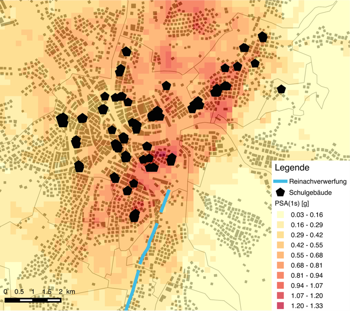Erdbebenvorsorge Basel

|
Following the seismic microzonation of Basel, the project «Basel Erdbebenvorsorge» was funded by the canton Basel-Stadt. It aimed first at improving the seismic network in Basel and collecting data for the next generation of microzonation studies, and second at proposing earthquake scenarios and risk computations for all cantonal school buildings. This study sets the framework for studies including the whole city, supporting earthquake mitigation and crisis management. In a first phase, 6 new modern strong-motion stations have been installed, complementing the installations from the SSMNet renewal project. The sites have been characterized through geophysical measurements. In addition, 5 temporary stations have been installed for the period of the project. In a second phase, a new amplification map was developed accounting for all information collected for the completed microzonation study and more recent data. The third phase was the development of a risk framework using the Openquake software. The company Resonance Ingénieurs-Conseils performed the assessment of the capacity curves of the school buildings, that were implemented through fragility curves. A particular focus of the project was put on the uncertainties of the risk-calculation process. Scenarios for typical events of the area were assessed, based on the historical seismicity and the de-aggregation of the regional seismic hazard. The effect of retrofitting of the school-building stock through the ongoing HARMOS project was quantified with a cost-benefit analysis. |
|---|---|
| Project Leader at SED | Donat Fäh |
| SED Project Members | Clotaire Michel |
| Funding Source | Kanton Basel-Stadt |
| Duration | 2013-2016 |
| Keywords | Seismic risk, seismic vulnerability, microzonation, school buildings, site effects, Openquake, strong motion |
| Research Field | Earthquake Hazard & Risk, Engineering Seismology |
Michel, C., Hannewald, P., Lestuzzi, P., Fäh, D., & Husen, S. (2017). Probabilistic mechanics-based loss scenarios for school buildings in Basel (Switzerland). Bulletin of Earthquake Engineering 15(4), 1471–1496. doi: 10.1007/s10518-016-0025-2
Michel, C., Fäh, D., Edwards, B., & Cauzzi, C. (2017). Site amplification at the city scale in Basel (Switzerland) from geophysical site characterization and spectral modelling of recorded earthquakes. Physics and Chemistry of the Earth, Parts A/B/C 98, 27-40. doi: 10.1016/j.pce.2016.07.005
Michel C., Fäh D. (2016). Basel earthquake risk mitigation - Computation of scenarios for school buildings. Technical Report. Zürich, Switzerland: ETH-Zürich. doi: 10.3929/ethz-a-010646514
Michel C., Fäh D., Edwards B., Cauzzi C. (2016, in press). Site amplification at the city scale in Basel (Switzerland) from geophysical site characterization and spectral modelling of recorded earthquakes. Physics and Chemistry of the Earth Special Issue “Advances in seismic site response: standard-practice and innovative methods”. doi: 10.1016/j.pce.2016.07.005
Michel, C., Fäh, D., Lestuzzi, P., Hannewald, P. and Husen, S. (2015). Detaillierte Erdbeben-Schaden-szenarien für die Schulgebäude im Kanton Basel-Stadt. Dokumentation SIA D 0255 Erdbeben und bestehenden Bauten, 14. D-A-CH-Tagung, Zürich.
Michel C., Hannewald P., Lestuzzi P., Fäh D., Husen S. (2016, in press). Probabilistic mechanics-based loss scenarios for school buildings in Basel (Switzerland). Bulletin of Earthquake Engineering. doi: 10.1007/s10518-016-0025-2
Résonance (2016). Basel earthquake risk mitigation – Capacity curves of school buildings. Technical Report. Zürich, Switzerland: ETH-Zürich. doi: 10.3929/ethz-a-010647300